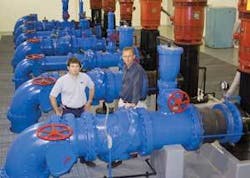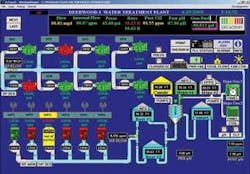Artificial Intelligence Helps JEA Optimize Water Resources
When management at JEA, the water, sewer and electric provider for Jacksonville, FL, was challenged by the St. Johns River Water Management District to reduce withdrawal of water from the area aquifer, they decided to do it in a big way - by using artificial intelligence.
In the past, JEA’s mode of operation has been to keep water tanks full and react to consumption after the fact. Reservoir water levels were kept constant regardless of use. When demand was high, wells were drawn down over time to levels that reduced their life. Pumps required frequent maintenance and used excessive energy because they switched off and on almost constantly.
While other utilities are investigating and experimenting with automated supervisory control − or artificial intelligence − of their pumping and distribution systems, JEA is believed to be the first to use such a system to directly operate a production well field.
JEA’s new system, Optimized System Controls of Aquifer Resources, or OSCAR, controls the water system in real time, creating what JEA refers to as Operations Optimization. This means the water system is monitored, regulated and adjusted every minute of the day, 365 days a year, creating a “just in time” water supply.
OSCAR regulates the pumping of water from the aquifer by evaluating data from a variety of sources. System Control and Data Acquisition (SCADA) is key to the optimization of this process. Idea Integration, the applications integration company, developed a system for JEA to extract and consolidate the required input data from SCADA and weather-related data. Idea also built the web application to display all forecasting and scheduling information for one of JEA’s two major grids in Jacksonville.
Using this data, JEA operators switch from reactive to proactive based on consumption forecasting. Energy consumption is then minimized while water generation is maximized during on-peak periods. Additionally, operations staff works with the software programs to develop optimized operating plans on an annual, weekly and daily basis, assuring up-to-date accuracy. Actual system conditions are compared to forecasts and operators are alerted to significant variations or equipment failures.
It would be impossible for a human operator to compare all these variables as frequently or with as much accuracy as the automated system. When needed, however, human operators can override the system to make adjustments for drought or other extreme conditions.
From an operations standpoint, a consumption forecaster takes this data and uses a “neural network” to predict sub-grid hourly consumption. Gensym Corp. was responsible for the software that actually generates the daily forecast and daily schedule for water to be pumped from each well for every individual water plant in the same grid. Gensym used heuristic algorithms to generate the forecast values based on historical water consumption data as well as weather-related data.
Pumping is assigned to the water plant closest in proximity to the need, augmented by plants farther away when necessary to meet demand. Adjustments can also be made to control flow from wells that may be overextended, pumping from wells that have more available water supply. This “system scheduler” also assigns plant flow based on cost criteria, energy value and water quality.
This process allows savings in several areas:
− The value of the energy used for the system is maximized because water use is predicted ahead of time and pumping is scheduled for times of day when energy costs are lower.
− Groundwater supplies are better managed, ensuring supplies for future generations.
− Salt intrusion into wells has been reduced, increasing water quality.
− Chemical costs for treating water are minimized because water is treated as it is needed.
− Capital costs are minimized through better use of existing assets.
The ultimate result is minimized well production during on-peak hours and optimized reservoir storage. In addition, pump starts are greatly reduced, increasing efficiency and lowering maintenance costs. Savings in the initial trial applications for the expert system and optimizer include an estimated $1.4 million in capital expenses and $170,000 per year in operating expenses, plus an increased potential for energy sale opportunities.
JEA implemented the OSCAR system a year ago on its south grid in Jacksonville, incorporating 15 plants and six wells. JEA plans to expand the system throughout its network of more than 39 facilities. By enhancing and optimizing this existing network, JEA can meet the demands of its growing customer base and reduce the need to dig new wells, preserving Florida’s aquifer for future generations.


